
It’s Pandan season again! Are you ready for some exciting new recipes to try? I know you do!
Anyways, before we go straight in to the 7 recipes I have promised you, let’s talk a little about this amazing plant called Pandan.
The Vanilla of the East
Pandan has always been part of traditional Asian cooking for decades and recently, it was discovered in the west as a magic plant that has various uses until it has been dubbed as the vanilla of the east by British Home Cook Sensation, Nigella Lawson.
I don’t want to dwell to much on the whats, hows, and whys of Pandan here because I am more interested to share with you 7 delicious traditional Malaysian sweetmeats or kueh that you can hardly find now even when you are in Malaysia. So, if you are still interested to know all about pandan and its health benefits, click here.
If you are more interested in learning about its uses in cooking, well, just go to our article that gives you not just one but seven clever ways to include pandan in your cooking. Once you’re done perusing, come back here and start practicing what you learn from those two articles.
Much cheaper than buying a ticket to Malaysia and sampling the kuehs! So, let’s get started.
1. Pandan Sponge Cake
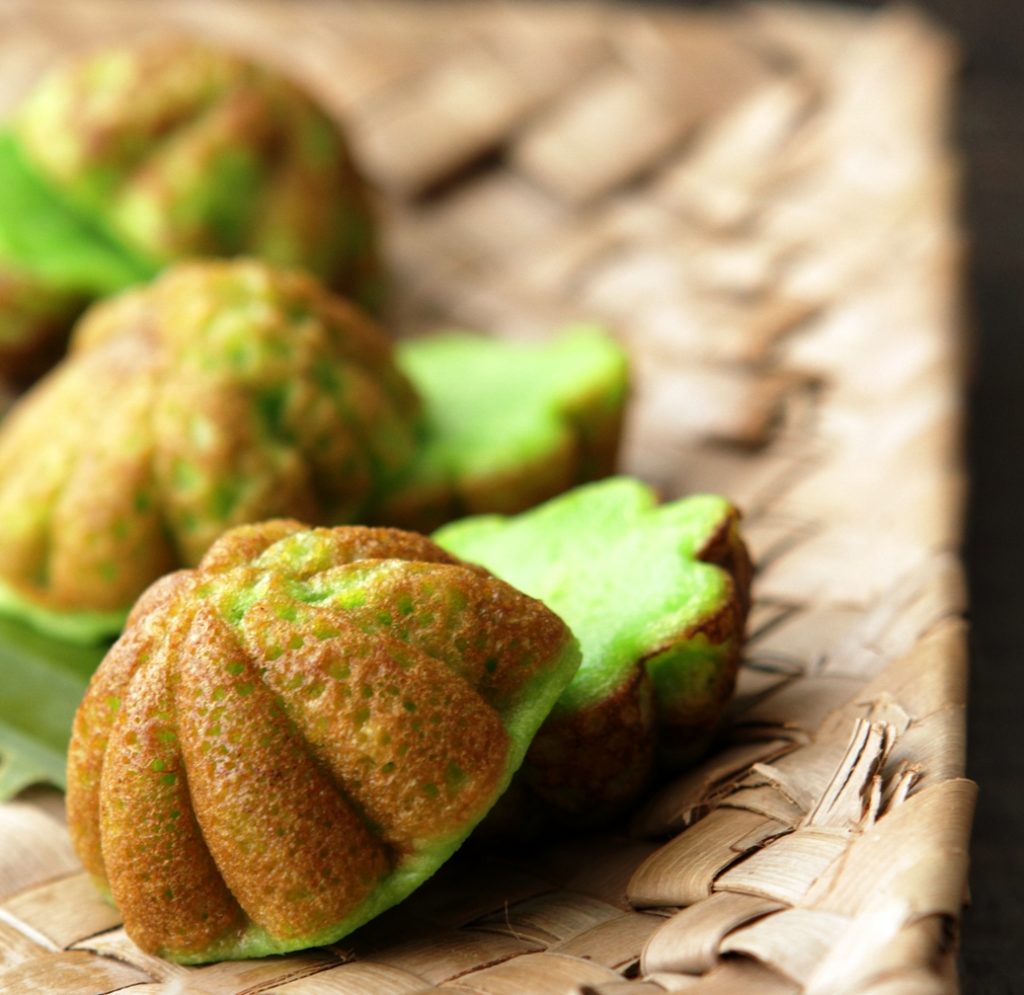
The first pandan-based traditional kueh that I have listed here is the pandan sponge cake or kueh cara manis. Despite its name, don’t be fooled!
The texture of the sponge cake is more chewy than spongy with an explosion of sugar syrup in the middle. A pleasant pick-me-up after a long day, if you ask me.
Ingredients:
a) Batter
- 1 cup of wheat flour
- 1/2 cup of thick coconut cream
- 1 large egg
- 3 tablespoons of vegetable oil
- 1 1/2 cup of pandan extract
- 1 teaspoon of salt
- 2 teaspoons of green colouring
b) Filling
- 100g of granulated white sugar
c) Other ingredients
- 1 pandan leaf
- 3 tablespoons of vegetable oil
Method:
- Blend the ingredients in A for the batter.
- Heat up the iron mould on the lowest fire.
- Oil the mould. Make sure there’s no excess oil pooled at the bottom.
- Add in the batter til 3/4 full.
- When the batter is cooked, about 3-4 minutes, add in the sugar.
- Cover the iron mould with a pot lid, Let the kueh fully cooked for 3 minutes.
- Remove the kueh from the mould. Repeat steps 3 til 7 until all the batter is finished.
2. Wajik
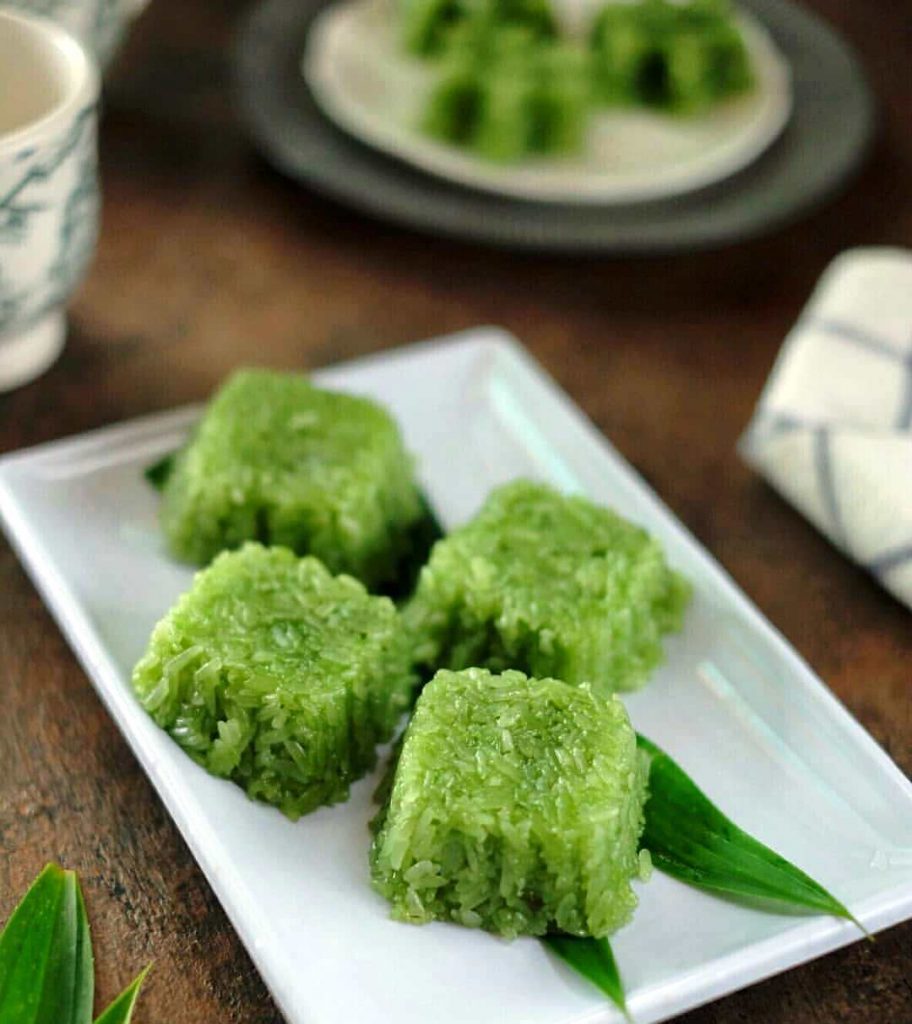
Wajik or wajid is a personal favourite of mine. It has a chewy, sticky texture that just makes you crave for more. If you happen to find someone selling wajik here, count yourself as lucky! It is so rare to find traditional Malaysian sweetmeats such as this one now since not many have the patience and the time to make it.
If you feel like having some wajik, just for the sake of trying, test out the recipe below. Make sure you make it pandan-flavoured!
Ingredients:
- 500g of glutinous rice
- 100g of granulated white sugar
- 750g of palm sugar
- 2 pandan leaves
- 375g of thick coconut cream
- Salt to taste
- 200ml of water
- 1 tablespoon of pandan extract
Method:
- Wash the glutinous rice and soak it overnight. Once done, steam it till cook.
- While waiting for the glutinous rice to cook, heat up a pot on medium heat and add the palm sugar, granulated sugar, pandan extract, pandan leaves and salt in 200ml water til dissolve. After that, sieve it.
- Add coconut cream into the sugar water and cook till thick and stringy.
- Add in the glutinous rice and stir till the mixture does not stick to the ladle.
- Place the mixture into a baking tray and flatten it. After it cools, cut and serve.
3. Steamed Rice Cake in Bamboo
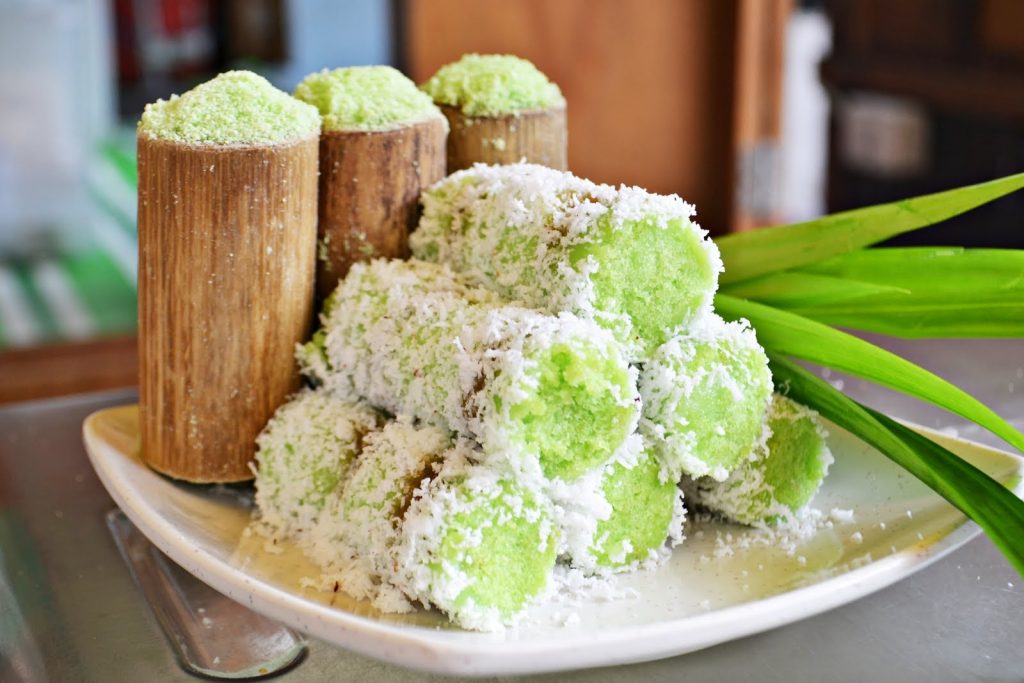
Steamed rice cakes in bamboo or putu bambu is a popular teatime delicacy in Malaysia and Indonesia. Usually, you can buy them from old uncles on motorcycles carrying a huge tiffin-like carrier behind them.
Ingredients:
- 400g of rice flour
- 150g of fresh dessicated coconut
- 125g palm sugar
- 300ml of water
- 2 pandan leaves
- 1 cap-full of green colouring
- Banana leaves (3cm diameter and 8cm long)
- Bamboo moulds
Method:
- Boil water in a pot on medium flame. Add in 1/2 tablespoon of salt and pandan leaves. Stir to dissolve the salt. Wait til the water starts to simmer and turn off the stove.
- In a big bowl, add in the rice flour. Pour in the water you have heated just now into the bowl, little by little. While pouring, put a cap of green colouring and slowly stir the mixture till tiny granules are formed.
- Use a perforated sieve and sift the mixture. Rub the remaining mixture in the sieve gently using your fingers till tiny beads form. Place the beads in a separate bowl. Repeat until all the flour mixture is
- Prepare the bamboo moulds and put in the mixture til 1/2 of the mould.
- Place a small piece of palm sugar in the middle and put in the flour mixture til 3/4 of the mould. Repeat the process till all the moulds are being filled.
- Prepare the steamer. Place a piece of banana leaf at the bottom of the steaming tray. Put all the moulds in and close the steamer. Let the cakes cooked for 10 minutes. Take out the moulds once the rice cakes are soft and fluffy.
4. Tepung Pelita
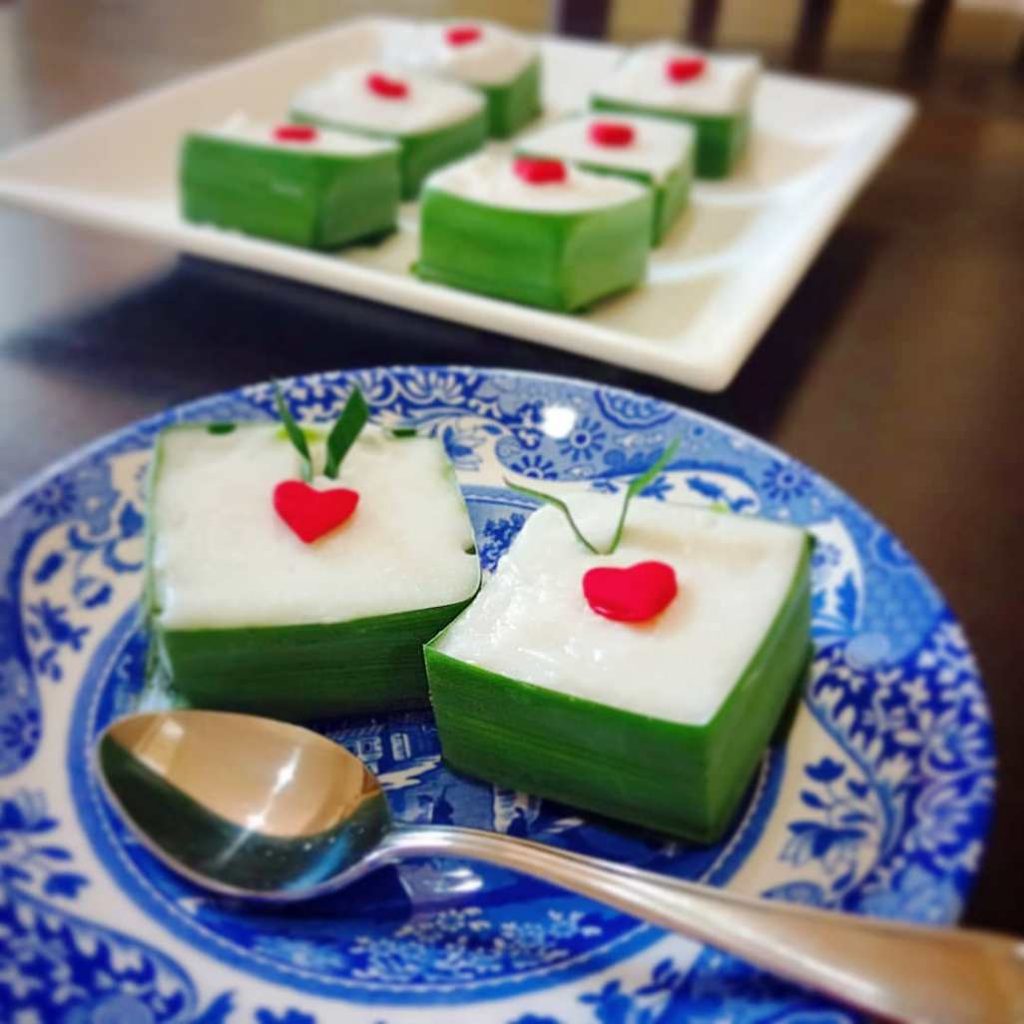
This kueh is a Ramadan special. It can only be found in abundance during the fasting month and whether its delicious or not (depending on how the vendors prepare it), they’ll be sold out within minutes!
So, instead of waiting a year til Ramadan comes again, why not make it on your own? Don’t worry about the banana leaf casing. You can use plastic cups as replacement.
Ingredients:
a) Bottom Layer
- 1 cup of rice flour
- 1 cup of white sugar
- 5 cups of water with 1 tablespoon of limewater
- 1 tablespoon of pandan extract
b) Top Layer
- 1 cup of coconut milk
- 3 tablespoons of rice flour
- 1 teaspoon of salt
Method:
- Mix all the ingredients in (a) together til well combined. Put it aside.
- In a separate bowl, mix all the ingredients in (b) til well combined. Put it aside. Meanwhile, prepare the steamer.
- Instead of making moulds using banana leaves, use small plastic containers instead. In each container, put 1 teaspoon of sugar. Then, pour the mixture for the bottom layer til it fills 1/3 of the container.
- Put the containers inside the steamer and let steam for 15 minutes. After that take them out and pour in the batter for the top layer.
- Place the containers back into the steamer and steam for 10 minutes.
5. Coconut Milk and Pandan Jelly

Who doesn’t love a good jelly? And this jelly recipe is one that you absolutely must try and keep. I don’t want to say much. I rather you try them yourselves!
Ingredients:
- 10g of agar-agar powder
- 800ml of water
- 200ml of first press coconut milk
- 3/4 cup (180g) sugar
- 1 cap-full of green colouring
- 1 large egg
- 1 teaspoon of salt
- 2 pandan leaves, tied into a knot
Method:
- In a pot, put in water, agar-agar powder, pandan leaves, sugar and green colouring. Heat the pot with medium flame and stir till the agar powder and sugar dissolved.
- Meanwhile, in a bowl, combine the coconut milk and egg. Set aside.
- Once the agar-agar mixture boils, pour in the egg and santan using a sieve and stir for 3-5 minutes while the mixture simmers.
- Pour in a circular tray and keep in the fridge for 2-3 hours or until set.
- You can make layers by separating the agar-agar mixture and boil one portion with the coconut milk and egg mixture. Pour the two mixtures in separate trays and let them set in the fridge. When ready to serve, place the coconut milk layer first and then the agar-agar layer.
6. Kuih Lopes
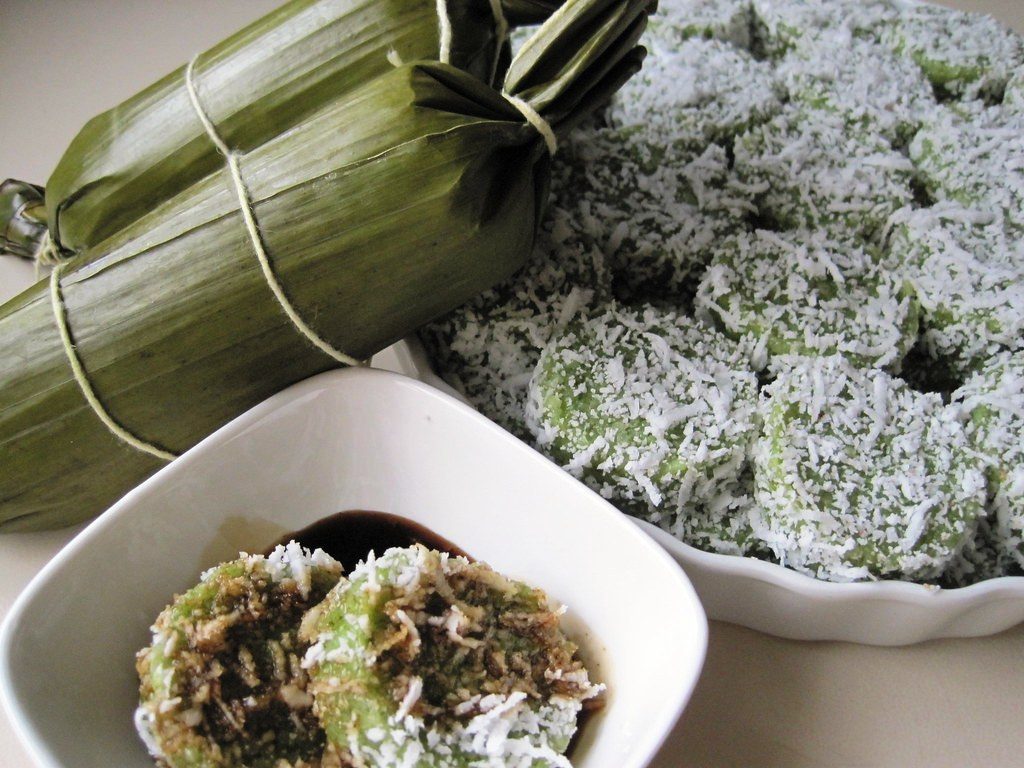
Next on our pandan kueh list is the kueh lopes. Now, don’t worry if you have not heard of this kueh before because it has never reach viral status like the other kuehs listed here. But that does not mean it taste any lesser.
Try the recipe below and see how your life will change.
Ingredients:
a) Glutinous rice
- 2 cups of milk glutinous rice
- 2 cups of second press coconut milk
- 1 tablespoon of pandan extract
- 1/2 teaspoon of limewater
- 1/2 teaspoon salt
- 3 drops of green colouring
- Desiccated coconut, mixed with 1/2 teaspoon of salt
- Banana leaves
b) Palm Sugar Syrup
- 100g of palm sugar
- 5 tablespoons of sugar
- 3 cups of water
- 2 pandan leaves, tie into a knot
Method:
a) Glutinous Rice
- Wash the glutinous rice and then soak it with some water, green colouring and limewater for 30 minutes.
- Toss out the glutinous rice and put it in a tray. Put in the coconut milk, salt and pandan juice. Mix well.
- Heat up the steamer and wait til the water boils. Steam for 10-15 minutes until the rice is 3/4 cooked.
- When the coconut milk dries up, fluff up the glutinous rice. Let steam for 2 minutes. Take out from the steamer and let cool.
- Take a strip of banana leaf that is wide enough for you to place the glutinous rice in the middle. Heat the leaf on top of fire for 1 minute. Don’t let it burn!
- Put the glutinous rice in the middle, not too much that you cannot roll it 2-3 times. Tie up the ends with a piece of string.
- Put all the rolls into the steamer again and steam for 15 minutes. After that, take them out and let cool.
- When serving, cut the roll of glutinous rice into small circles and roll them onto the salted desiccated coconut prepared earlier.
b) Palm Sugar Syrup
- Put all the ingredients into a pot. Let them come to a boil and reduce the flame.
- Stir till becomes thick. Remove from stove and let cool completely. Enjoy with the glutinous rice circles.
7. Kuih Sagu Pandan
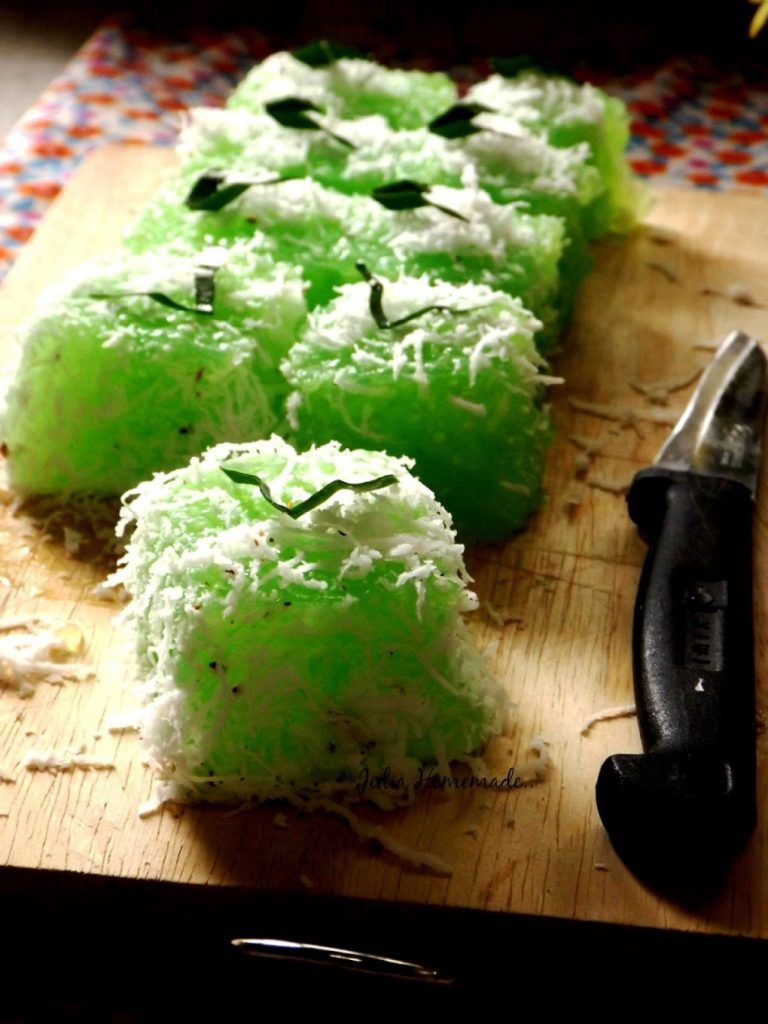
Finally, the seventh kueh in this article is the unforgettable kueh sagoo. The recipe is so easy that you can just make it anytime, anywhere. Want kueh sagoo for dinner? Why not? You have the recipe right here.
Ingredients:
- 1 cup of sagoo
- 2 cups of water
- 3/4 cup sugar
- 200g of desiccated coconut, mixed with 1/2 teaspoon of salt
- 3 drops of green colouring
- 1 tablespoon of pandan extract
Method:
- Heat some water in a pot and put in 3 drops of green colouring. Let it comes to a boil.
- Put in the sagoo and stir till thickens.
- Put in the pandan juice. Mix well and take off the stoce. Pour the mixture into a tray greased with some vegetable oil and steam for 20-25 minutes.
- Take out the tray and let it cool for 5-10 minutes. Cut into squares and roll on the salted desiccated coconut prepared earlier.
There’s More!
We have come to the end of this article and trust me, if I have to list all of the pandan-flavoured traditional Malaysian kueh, this article will never end!
So, do me a favour, try these recipes, share your results with us on Instagram and Facebook by putting #butterkicap, leave a comment and I will share more traditional kueh recipes for you to try at home.
